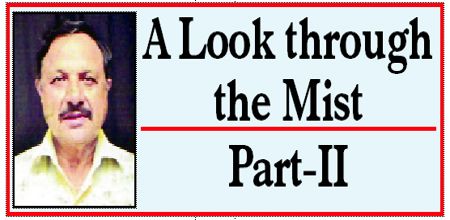Status of President of India was very considerately enshrined as protector of COI under Art-60
Constituent Assembly firmly & solemnly resolved to proclaim India as an Independent Sovereign Republic
President takes oath to protect COI but 42nd& 44rth amendments of COI are not fair to President

DAYA SAGAR
British was very actively involved in 2nd World War in 1942 On the lines of demand for Pooran Swaraj Gandhi finally gave Quit India call against the Crown on 8th August 1942 even when many senior leaders of even Congress were suggesting that such call may annoy British worth delaying independence.
After the visit of Cabinet Mission to India atlast in principle it had been decided in 1946 that India will be granted ‘freedom’. So under the Cabinet Mission Plan of 1946, elections were held for a Constituent Assembly of India to frame the constitution . For Constituent Assembly of free India of future , members were chosen by indirect election by the members of the Provincial Legislative Assemblies in terms of a single transferable vote of proportional representation ( according to the scheme recommended by the Cabinet Mission).. The first meeting of the Constituent Assembly took place on December 9, 1946 at New Delhi where Dr Sachidanand eldest member elected as the interim President of the Constituent Assembly. In the first meeting the Muslim League members had boycotted since they demanded partition of India. However, on December 11, 1946, Dr. Rajendra Prasad was elected as the President and H.C. Mukherjee as the Vice-President . Those who adorned the front row included Pandit Jawaharlal Nehru, Maulana Abul Kalam Azad, Sardar Vallabhbhai Patel, Acharya J.B. Kripalani, Dr. Rajendra Prasad, Smt. Sarojini Naidu, Shri Hare-Krushna Mahatab, Pandit Govind Ballabh Pant, Dr. B.R. Ambedkar, Shri Sarat Chandra Bose, Shri C. Rajagopalachari and Shri M. Asaf Ali. Two hundred and seventy nine representatives, including nine women were present.
On 13 December, 1946, Pandit Jawaharlal Nehru moved the Objectives Resolution that among others included :”This Constituent Assembly declares its firm and solemn resolve to proclaim India as an Independent Sovereign Republic and to draw up for her future governance a Constitution;. Wherein the territories that now comprise British India, the territories that now form the Indian States, and such other parts of India as are outside British India and the States as well as such other territories as are willing to be constituted into the Independent Sovereign India,shall be a Union of them all; and ..”: The Resolution was unanimously adopted by the Constituent Assembly on 22 January 1947.
In view of the partition of India & enactment of Indian Independence Act by British Parliament ( taking leads from the Mountbatten Plan of 3 June, 1947), a separate Constituent Assembly was to be set up for Pakistan hence the membership of the Constituent Assembly for India Dominion was reduced to 279 ( 229 were from the British Indian provinces while the remaining 70 were from the princely states ).
Mr. B N Rau ( ICS 1909) , who was a very experienced civil servant during British times and had also wide experience of governance /needs of Indian communities though was not made the member of constituent Assembly but was retained as Constitutional Advisor.
The Constituent Assembly had made 17 committees including the one as Drafting Committee with Dr Bhim Rao Ambedkar as Chairman ( On 29 August, 1947 ) i.e. 1. Committee on the Rules of Procedure Rajendra Prasad 2. Steering Committee Rajendra Prasad 3. Finance and Staff Committee Rajendra Prasad 4. Adhoc. Committee on the National Flag Rajendra Prasad 5.Credential Committee Alladi Krishnaswami Ayyar 6.House Committee B. Pattabhi Sitaramayya 7.Order of Business Committee K.M. Munsi 8. Committee on the Functions of the Constituent Assembly G.V. Mavalankar 9. States Committee Jawaharlal Nehru 10.Advisory Committee on Fundamental Rights, Minorities and Tribal and Excluded Areas Vallabhbhai Patel 11. Minorities Sub-Committee H.C. Mookherjee 12.Fundamental Rights Sub-Committee J.B. Kripalani 13.North-East Frontier Tribal Areas and Assam Excluded & Partially Excluded Areas Sub-Committee Gopinath Bardoloi 14. Excluded and Partially Excluded Areas (Other than those in Assam) Sub-Committee A.V. Thakkar 15. Union Powers Committee Jawaharlal Nehru 16.Union Constitution Committee Jawaharlal Nehru 17. Drafting Committee B .R. Ambedkar.
To be continued
(The author is a Sr Journalist &
analyst of J&K Affairs. [email protected]).
